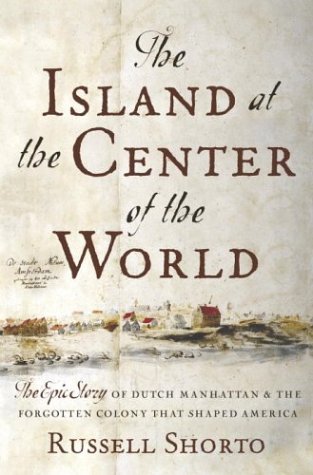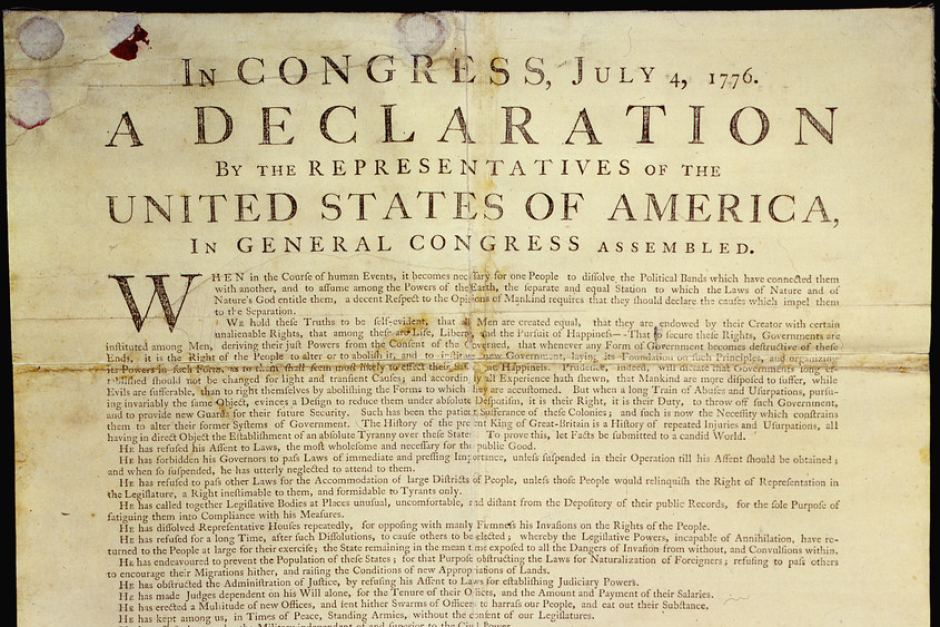The Island at the Center of the World: The Epic Story of Dutch Manhattan and the Forgotten Colony that Shaped America, by Russel Shorto
Everybody is familiar with at least the general outlines of the American Revolution: how the thirteen colonies of North America rebelled against the tyranny of the English and George III to create a free republic based upon the principle that all people should be entitle to equal treatment under the law.
The famous second paragraph of the American Declaration of Independence pretty much says it all:
“We hold these truths to be self-evident, that all men are created equal, that they are endowed by their Creator with certain unalienable Rights, that among these are Life, Liberty and the pursuit of Happiness. — That to secure these rights, Governments are instituted among Men, deriving their just powers from the consent of the governed, — That whenever any Form of Government becomes destructive of these ends, it is the Right of the People to alter or to abolish it, and to institute new Government, laying its foundation on such principles and organizing its powers in such form, as to them shall seem most likely to effect their Safety and Happiness.”
Ask ten Americans, and nine of them will likely tell you that America was the very first country to try this radical experiment in republican democracy, and that this is one of the things that make America unique among nations.
The tenth American might tell you something else.
That America, in fact, was the second nation to launch a rebellion against a tyrannical European monarchy and found a free republic.
The first nation to do so was the Netherlands.
Two centuries before the thirteen colonies attempted it, the Dutch made their own bid for independence. The tyrannical European monarchy they rebelled against was the Spanish Hapsburg Empire. It was a long slog, though. The conflict their rebellion caused is known as the Dutch War of Independence, or simply the Eighty Years’ War, for it lasted from 1568 to 1648.
By the time the Dutch finally gained formal recognition as an independent nation in 1648, they had already created a vibrant republic—a republic that in many ways prefigured the American one. They even had their own constitution: the Union of Utrecht, created in 1579. In this document they laid out a blueprint for a republic that was, for the times, shockingly tolerant. Look at the following, for instance, taken from Article XIII:
“As for the matter of religion, the States of Holland and Zeeland… and the other Provinces of this Union shall… establish such general or special regulations in this matter as they shall find good and most fitting for the repose and welfare of the provinces, cities, and individual Members thereof, and the preservation of the property and rights of each individual, whether churchman or layman, and no other Province shall be permitted to interfere or make difficulties, provided that each person shall remain free in his religion and that no one shall be investigated or persecuted because of his religion.”
The Netherlands in the seventeenth century was a bastion of religious and intellectual freedom, of egalitarian republican sentiments, of capitalist entrepreneurs, and of an incredible flowering of the arts (think Frans Hals, Rembrandt van Rijn, Johannes Vermeer et al). Jewish Marranos, hounded out of the Iberian Peninsula by the Spanish Inquisition, flocked to Amsterdam, where many of them became successful merchants. Radical European intellectuals like René Descartes made their home in the new Dutch republic, seeking both safety and book publishers (half of all the books published in Europe in the seventeenth century were printed by Dutch publishers). The seventeenth century Dutch virtually invented—or at least perfected—the limited liability corporation and the stock market.
All this forms the background to Russel Shorto’s The Island at the Center of the World.
The blurb on the front cover of my copy of this books (a quote from a New York Times review) claims this is “a book that will permanently alter the way we regard our collective past.” That may sound like hyperbole, but I reckon it’s actually a fairly accurate assessment.
The thesis of the book is quite fascinating.
Here’s how Shorto himself puts it:
 The new government the united Dutch provinces formed during their struggle was something utterly anomalous in Europe: in the midst of the great age of monarchies, stretching from Elizabeth Tudor to Louis XIV, the Dutch carved out a republic… They had a cultural distaste for monarchy and ostentation… They believed in hard work, in earning an honest guilder, in personal modesty. They thought the English preoccupation with witches was paranoia…The Dutch dressed so simply that foreigners complained that in the streets of Amsterdam it was impossible to tell the difference between a city magistrate and a simple shopkeeper
The new government the united Dutch provinces formed during their struggle was something utterly anomalous in Europe: in the midst of the great age of monarchies, stretching from Elizabeth Tudor to Louis XIV, the Dutch carved out a republic… They had a cultural distaste for monarchy and ostentation… They believed in hard work, in earning an honest guilder, in personal modesty. They thought the English preoccupation with witches was paranoia…The Dutch dressed so simply that foreigners complained that in the streets of Amsterdam it was impossible to tell the difference between a city magistrate and a simple shopkeeper
The whole package—the young and vibrant republic, the war for independence, the hard-nosed practical populace that disdains monarchies and maintains a frank acceptance of difference—has a familiar ring to it… Some of those similarities are inevitable (don’t all rebellions have heroes and martyrs?), but the most elemental one—a cultural sensibility that included a frank acceptance of difference and a belief that individual achievement matters more than birthright—is, as I hope this book will show, at least in part the result of a kind of genetic transfer from the one culture to the other, a planting of Dutch notions in one vital region of the future United States, from which they would be taken up into the American character.
That “one vital region” is the island of Manhattan—the island at the center of the word, as Shorto characterizes it.
This book tells the story of the Dutch colony on Manhattan Island, of its founding and turbulent beginnings, its gradual coalescing into a successful settlement characterized by tolerance and diversity , and its relinquishing to the English and eventual incorporation into the fledgling United States of America.
The Island at the Center of the World is not a book about Barbary corsairs, so it’s a bit of a stretch, perhaps, for me to be recommending it here in this blog. It is, however, a book that focuses on the period when Barbary corsairs were at their height, and it provides useful background information to the period—which can’t be bad. More importantly, though, it’s a book they really does alters one’s understanding of our collective past.
In my experience, the most interesting historical non-fiction books all do that: they present past events in such a way as to allow the reader to see them from a new perspective.
The Island at the Center of the World does this for Manhattan, and for America. Russel Shorto lays out the details of the Dutch contribution in a very effective narrative focused on the various people who played important roles as events unfolded (Chapter IV, for example, is titled The King, the Surgeon, the Turk, and the Whore).
The Island at the Center of the World is a well researched, well written book that not only recounts a fascinating tale but also shines a light onto a forgotten corner of our collective past and, in so doing, allows us to understand it in a new way.
What could be better than that?

Corsairs and Captives
Narratives from the Age of the Barbary Pirates
View Amazon listing
The Travels of Reverend Ólafur Egilsson
The story of the Barbary corsair raid on Iceland in 1627
View Amazon listing
